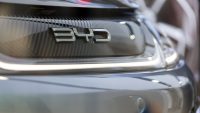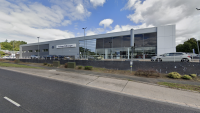JLR is to hold back on manufacturing the models that make it less money until microchip supplies get easier.
Chief executive Adrian Mardell was quoted by Autocar as saying that full-scale production of the Range Rover Evoque, Land Rover Discovery Sport, Jaguar XF, and Jaguar XE, pictured, which are its cheaper vehicles, wouldn’t be happening for a number of months.
Instead, it’ll keep focusing on making the much more successful and profitable Defender, Range Rover and Range Rover Sport models.
These three played a large part in increasing its revenue and cutting its losses last year, it said, making up more than 75 per cent of its 200,000-strong unfulfilled customer order bank.
That backlog, as well as their higher profitability versus other JLR cars, means manufacturing them will be taking priority while the chip supply problem remains.
Mardell was asked by Autocar for a production update on the Defender, Range Rover and Range Rover Sport and told the publication: ‘We’re three shifts in two areas [Solihull and Nitra], and we’re on single shift at the other production facilities [Halewood and Castle Bromwich] and that will continue over the first six months of the year.
‘We’re not stimulating orders for those other products yet, until we can get confidence of supply.
‘The order rates we are receiving at Halewood and Graz [where Magna builds the Jaguar E-Pace] are consistent with the build that we can actually produce today, so we’re very balanced, and those orders have stayed pretty consistent over the last months.’
JLR has to make 300,000 cars a year to break even, which it did last year, and Autocar quoted Mardell as saying that a third of them must be Range Rover or Defender at the moment to meet targets for profitability.
The Land Rover models, which are cheaper, certainly have a future, and Halewood is being converted for the electric Velar, Discovery Sport and Evoque production from late 2024.
But Mardell added the caveat ‘whether we eliminate some of the lower-value derivatives, we will decide as we go forward’.
He is confident that the supply of semiconductors will carry on improving this year and into next.
However, other obstacles in production, such as tooling breakdowns, were likely to happen ‘most weeks over the next six to nine months’.


































